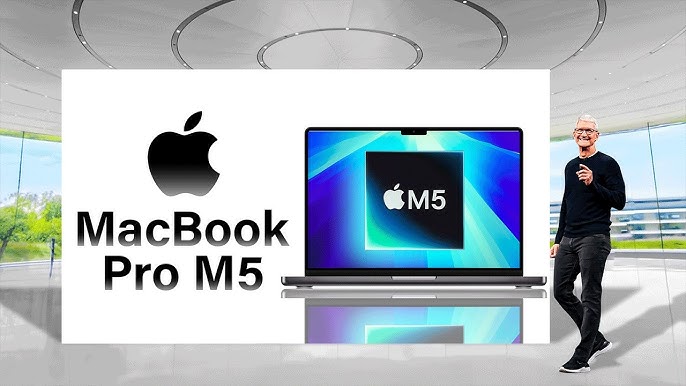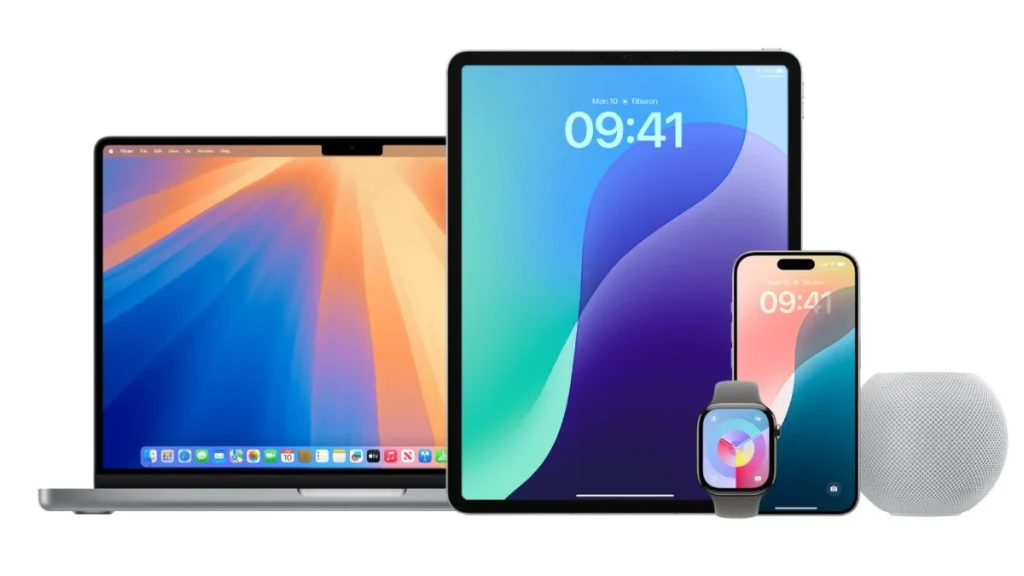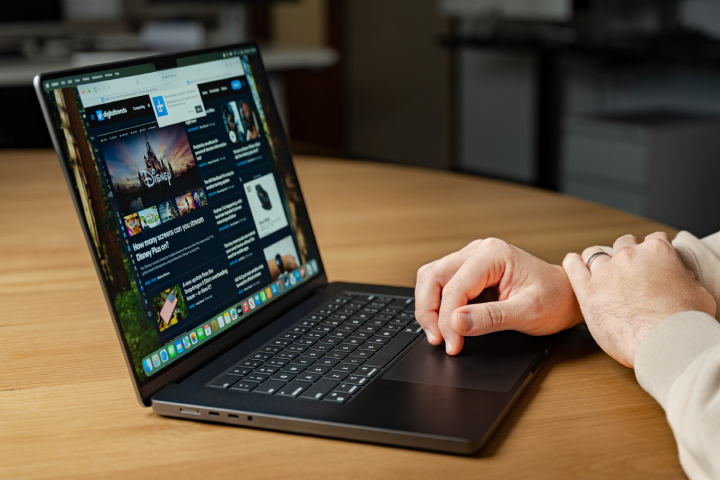
The Apple MacBook Pro M5 launch is shaping up to be one of the most important events for Mac users this year. Apple has been aggressively advancing its silicon roadmap, and the Apple MacBook Pro M5 represents the next leap after the already impressive M4 series. Why does this matter so much now? Because Apple is betting on the M5 generation to deliver industry-leading performance, even better energy efficiency, and improved AI acceleration to future-proof creative workflows and professional tasks.
Expected to arrive in the final quarter of 2025, likely around October or November, the Apple MacBook Pro M5 will be part of Apple’s broader strategy to refresh its entire Mac lineup with cutting-edge silicon. Reports indicate at least 15 new Mac models are in active development, showcasing Apple’s ambition to dominate both consumer and professional segments with in-house chips.
For users weighing an upgrade, the Apple MacBook Pro M5 is positioned as an evolutionary but critical step, with refined specs, robust connectivity like Wi‑Fi 7 and Thunderbolt 5, and design continuity that ensures proven reliability. In this blog, we’ll break down the timing, specs, and strategy behind the Apple MacBook Pro M5 to help you decide if it’s the right Mac for your future.
Launch Timing & Context
Apple is widely expected to unveil the Apple MacBook Pro M5 in Fall 2025, with the launch window most likely falling in October or November. This timing is no accident—it fits perfectly into Apple’s established yearly refresh cycle for its high-end MacBook Pro lineup. Historically, Apple has used the October–November window to introduce major MacBook Pro updates, aligning with back-to-school buying trends and the holiday shopping season.
The Apple MacBook Pro M5 is the next logical step in Apple’s aggressive silicon evolution. After debuting the M1 in late 2020 and quickly moving through the M2 in 2022 and M3 in late 2023, Apple surprised many by pushing out the M4 in early 2025 for select models. The M5 is set to consolidate these gains, delivering another leap in CPU/GPU performance, energy efficiency, and AI processing capabilities.
In essence, the Apple MacBook Pro M5 represents Apple’s strategy of tightening its development cycle to maintain clear performance leadership over Intel- and AMD-powered Windows laptops. By advancing the M-series at this pace, Apple is reinforcing its commitment to in-house design and vertical integration, ensuring the Apple MacBook Pro M5 will be one of the most anticipated laptop launches of the year.
Also Read: Nothing OS 4.0 on Android 16 Coming This Autumn
What’s New in the Apple MacBook Pro M5?

Apple’s upcoming Apple MacBook Pro M5 is expected to arrive in multiple chip variants: the standard M5, the higher-performance M5 Pro, and the top-tier M5 Max. This tiered approach mirrors Apple’s recent MacBook Pro strategy, giving users a range of power and pricing options tailored for everyone from students to creative professionals and software developers.
Under the hood, the Apple MacBook Pro M5 is projected to deliver a substantial performance boost of approximately 15–25% over the already fast M4 models. This uplift will come from architectural refinements and increased CPU and GPU core counts in the Pro and Max variants. For example, the M4 Pro has 12 CPU cores and 18 GPU cores; the M5 Pro is rumored to push even further, with extra efficiency cores for better multitasking and higher GPU performance for demanding graphics work.
Crucially, the Apple MacBook Pro M5 will benefit from TSMC’s latest fabrication process, likely the advanced N3P node or an even more refined variant. This cutting-edge process not only increases transistor density for better raw performance but also improves energy efficiency—translating to cooler operation, longer battery life, and reduced thermal throttling even under heavy loads.
Apple is also investing heavily in AI/ML acceleration within the M5 family. The Apple MacBook Pro M5 will feature upgraded Neural Engine cores optimized for on-device AI tasks—from creative workflows like image generation and video editing to productivity features such as transcription, translation, and personalized automation. These AI/ML improvements ensure the Apple MacBook Pro M5 is not just faster but smarter, ready to support the new generation of AI-powered macOS features Apple is expected to roll out alongside its hardware.
Design & Build
The Apple MacBook Pro M5 is expected to maintain the same overall chassis design as the current 14-inch and 16-inch MacBook Pro models, underscoring Apple’s confidence in its already successful industrial design. This means buyers can anticipate the familiar squared-off, all-aluminum unibody with a robust hinge, large Force Touch trackpad, and the crisp Liquid Retina XDR mini-LED display that has earned widespread praise for color accuracy and brightness.
While the Apple MacBook Pro M5 won’t deliver a dramatic physical redesign, Apple is rumored to be considering subtle refinements to keep the line fresh. One possibility is an expanded range of finishes, with color options such as the popular “Space Black” seen on some M3 Pro models making a return. Such changes would give professionals a chance to customize their setup slightly while retaining the premium, understated aesthetic the MacBook Pro line is known for.
For those hoping for a radical visual overhaul or cutting-edge OLED display technology, reports suggest they’ll have to wait until at least 2026, when the M6 generation is expected to introduce a significant redesign. By holding the OLED transition for that cycle, Apple is focusing the Apple MacBook Pro M5 on delivering internal performance gains and feature refinements while ensuring proven reliability in the chassis. This consistency will appeal to creative professionals and businesses that prioritize durability and familiarity, making the Apple MacBook Pro M5 an evolution rather than a revolution in MacBook Pro design.
Key Specs & Features
The Apple MacBook Pro M5 is shaping up to be a powerhouse with thoughtful, targeted upgrades aimed at professionals who need reliable, high-performance computing. At the core of the improvements will be CPU and GPU upgrades across all M5 variants. The base M5 chip is expected to feature more efficiency and performance cores compared to the M4, while the M5 Pro and M5 Max versions will deliver even higher core counts—perfect for intensive workloads like 3D rendering, software development, and high-resolution video editing.
Apple is also expected to maintain the base RAM configuration at 16 GB, which has become the standard for its Pro models. However, the Apple MacBook Pro M5 will leverage faster memory speeds thanks to updated LPDDR5X or LPDDR6 standards. This means users will see snappier app launches, better multitasking, and improved performance in memory-intensive creative software—all without changing the baseline price for the entry configuration.
Storage tiers are projected to remain similar, with options ranging from 512 GB up to 8 TB, but Apple is likely to introduce faster SSD controllers for even quicker read/write speeds. This will be especially beneficial for professionals handling massive video files or large codebases who need instant access to data.
Connectivity will see a notable leap forward in the Apple MacBook Pro M5. Support for Wi‑Fi 7 is expected, enabling faster and more reliable wireless networking—critical for creative professionals who work in shared spaces or rely on cloud workflows. Thunderbolt 5 is also on the table, promising improved bandwidth for external displays, faster data transfer, and support for even more powerful accessory ecosystems.
Beyond raw specs, Apple is investing heavily in AI acceleration and thermal management for the Apple MacBook Pro M5. Expect an upgraded Neural Engine that handles machine learning tasks on-device with greater speed and efficiency, ideal for AI-enhanced creative tools, transcription, and automation in macOS. Additionally, refinements in cooling design will allow sustained peak performance with less fan noise and lower chassis temperatures, ensuring the Apple MacBook Pro M5 is both faster and more comfortable to use over long sessions.
Also Read: Lumio Arc 5 and Arc 7 Projectors with Google TV Set to Launch in India on July 7
Pricing & Configurations
Apple is expected to keep the Apple MacBook Pro M5 pricing structure closely aligned with that of the M4 models, maintaining its appeal to both creative professionals and power users who rely on Apple’s consistent premium experience. For the 14-inch Apple MacBook Pro M5, pricing will likely range from approximately $1,600 for the base M5 variant to around $3,200 for fully configured M5 Pro or M5 Max versions.
The larger 16-inch Apple MacBook Pro M5 will continue to target the high-end professional market, with starting prices anticipated at around $2,500, scaling up past $4,000 for top configurations. This approach ensures Apple keeps a tiered system that caters to students, freelancers, and large studios alike while maintaining the prestige and build quality the MacBook Pro is known for.
It’s important to note that these price points can vary by region due to local taxes, import duties, and currency exchange fluctuations. European customers, for instance, often see higher baseline pricing due to VAT, while other markets may face shipping surcharges or adjusted pricing strategies based on demand.
Despite these potential variations, Apple’s pricing philosophy for the Apple MacBook Pro M5 will likely mirror its approach with previous generations: a predictable, premium tier that emphasizes quality, longevity, and robust after-sales support. This pricing consistency is part of what keeps the Apple MacBook Pro M5 a strong choice for professionals who want powerful, reliable machines with few compromises.
Apple’s 2025–2026 Mac Roadmap

The Apple MacBook Pro M5 isn’t launching in isolation—it’s part of Apple’s ambitious, coordinated push to transition its entire Mac lineup to the next-generation M5 architecture. Industry reports suggest Apple has at least 15 new Mac models in development, ranging from ultra-portable devices to desktop workhorses, all leveraging the M5 family’s improvements in performance, efficiency, and AI acceleration.
Alongside the Apple MacBook Pro M5, we’re likely to see new MacBook Air models with the base M5 chip, giving mainstream users a taste of Apple’s latest silicon at a lower price. The Mac mini and iMac lines are also expected to receive M5 and M5 Pro options, broadening Apple’s strategy of vertical integration and maximizing the flexibility of its custom silicon. By aligning the entire Mac range around the M5 generation, Apple ensures software optimization is seamless, maintenance costs are lower, and customers get a consistent experience across form factors.
Looking further ahead, Apple’s roadmap doesn’t stop with the Apple MacBook Pro M5. Reports indicate that 2026 will bring a much more dramatic overhaul with the M6 generation. This next cycle is expected to introduce the first MacBook Pros with OLED displays, offering even better contrast, deeper blacks, and potentially thinner, lighter designs. The M6 chips themselves will also push Apple Silicon to new heights with further AI and GPU advancements, making them a tempting option for those willing to wait another year.
For now, though, the Apple MacBook Pro M5 serves as Apple’s flagship for 2025, anchoring a comprehensive lineup refresh that’s designed to keep Mac competitive and compelling in a crowded market. By delivering iterative but meaningful improvements across so many products, Apple is making a clear statement about its commitment to the Mac as a platform—and the Apple MacBook Pro M5 is at the center of that strategy.
Read More: Moto G96 5G to Launch in India on July 9 – Colors and Key Specs Unveiled
Should You Upgrade?
If you’re considering the Apple MacBook Pro M5, there are compelling reasons to make the leap—but also a few factors that might encourage you to wait. Let’s break down the pros and cons clearly.
Pros:
One of the biggest advantages of upgrading to the Apple MacBook Pro M5 is the significant speed boost it offers. With projected 15–25% performance improvements over the M4, plus higher CPU and GPU core counts in the Pro and Max variants, users working in video editing, 3D modeling, or software development will see real, tangible gains. This makes the Apple MacBook Pro M5 ideal for creative professionals who demand fast rendering times and seamless multitasking.
The Apple MacBook Pro M5 is also designed to be genuinely future-proof. With new AI-ready features built into the silicon itself, the laptop will handle the next wave of AI-enhanced creative tools and macOS automation smoothly. Whether it’s AI-assisted photo editing, voice-to-text workflows, or real-time transcription, the Apple MacBook Pro M5 is ready to make these tasks faster and more efficient right out of the box.
Cons:
However, it’s important to recognize that the Apple MacBook Pro M5 is an evolutionary update rather than a revolutionary one. The physical design remains largely unchanged from the current 14-inch and 16-inch models, which might feel underwhelming if you were hoping for something bold and new.
Another big consideration is that OLED display technology is reportedly being saved for the next generation—the M6 models coming in 2026. If you want the best possible screen, waiting an extra year could be worth it.
Finally, the current M4 MacBook Pro models are still extremely powerful, offering excellent performance and value for many users. For those who don’t need the latest and greatest, the M4 remains a strong, often discounted alternative to the Apple MacBook Pro M5, making the upgrade decision less urgent for more casual or budget-conscious buyers.
Conclusion
The Apple MacBook Pro M5 stands out as a solid, forward-focused update in Apple’s professional laptop lineup. While it may not introduce a bold new design or revolutionary display technology, it offers meaningful improvements in performance, efficiency, and AI capabilities. With enhanced CPU and GPU cores, faster memory, Wi‑Fi 7, Thunderbolt 5, and stronger machine learning acceleration, the Apple MacBook Pro M5 is purpose-built for professionals who rely on cutting-edge performance and long-term reliability.
That said, this is very much an evolutionary step—not a radical transformation. Apple has chosen to keep the proven 14- and 16-inch chassis, saving major design shifts and OLED display upgrades for the 2026 M6 generation. As such, potential buyers should carefully weigh whether the performance and AI enhancements of the Apple MacBook Pro M5 meet their current needs or if waiting for next year’s bigger redesign is the smarter move.
If you’re in need of serious computing power now, the Apple MacBook Pro M5 will likely be one of the most capable laptops on the market when it launches. But if you’re aiming for cutting-edge visuals and a reimagined form factor, holding off until 2026 could be worthwhile.
Stay tuned as Apple prepares to officially unveil specs, pricing, and release dates later this year. The Apple MacBook Pro M5 is coming—and it’s bringing the future of Mac with it.


